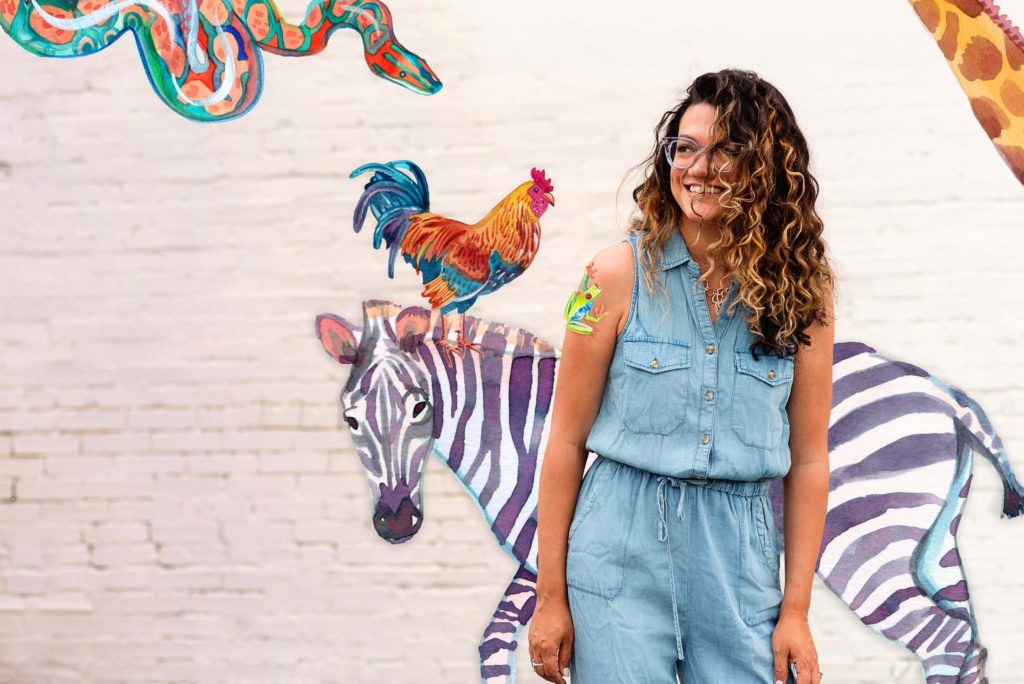
Amarilys Henderson, author of Drawing and Painting Expressive Little Faces and Drawing and Painting Expressive Little Animals, is a watercolor illustrator who specializes in surface design. We asked Amarilys a few question about her artistic process.
Quarto Creates: How did you first become interested in painting and drawing animals?
Amarilys Henderson: As most artists may say, drawing and painting was in my bones from a young age. But I can’t say I felt comfortable with animals until thirty years in to this life! I distinctly remember having a conversation with a new friend. She had taken me under her wing as I was new in town. A print of a cow painting hung over the dining room table and smaller paintings of other animals peppered about. I knew what she would ask, “do you do paintings of animals?” I quickly said no despite wishing to further secure my one new friend. Hearing myself proclaim it, though, didn’t feel freeing–like I can mark that off my repertoire and move on–but rather those words lingered like a challenge. So I took on a few animals! Portraits were an easier channel for me as I enjoy painting faces. I then gained enough gumption to face their very-different animal bodies.
QC: What is your advice for those who want to try it but aren’t sure where to start?
AH: As intimidating as it may sound, I find it useful to sketch with a big brush and some inexpensive paper. You won’t be able to have the luxury of focusing on every little detail with a big brush in hand, you’ll have to be loose. Focus on the silhouette of the animal. By this I don’t mean to look at its outline, but rather the big masses that make up the form. My favorite section in the book is one single spread that guides you through this. We take animals and break them down into shapes. The head may be a ball with a rectangular snout jutting out from it. The legs are long or stout rectangles often connected by an oval shape as its hip. This is an exercise in simplifying and seeing differently. And you’ll find yourself looking at forms and not the majestic animals you’ve loved since childhood.
QC: Have your finished products ever turned out different than your expectation, and how do you deal with that?
AH: Yes, how often? Every time. My finished work looks different than how it looked in my mind’s eye. Lots of factors play here–it’s not just our perceived lack of skill! For one, we look at things as a whole impression. We fail to notice the shape of whiskers or the strange way a horse’s hind leg juts backward. It’s not until you’re in the thick of creating that you notice these. I also am a big believer that creating is a partnership. I’m not the owner, implementer, and perfecter of a work. We never work alone. As Julia Cameron says, “Creativity requires faith. Faith requires that we relinquish control.” We are channels of creativity.
One contributor is the medium itself… particularly watercolor. It plays a role in what it will create. I’ve learned to let it do what it does best, even if I wasn’t asked for permission to proceed! I’ve seen too many pieces come through my hands that weren’t what I expected–and was pleasantly surprised. The more you do it, the more faith in your own work you’ll have to try again.
QC: Where do you look for inspiration?
AH: Two sources of inspiration for me are children’s books from the fifties and my newfound love for quilts! The first–think Little Golden Books–are my go-to’s. I can’t help but feel uplifted by their themes, drawn in by the compositions and intrigued by their color palettes. Pink often makes an appearance and that certainly does not hurt! Quilting is not a skill I’ve developed, but I’m drawn to seeing how a collection of patterns and colors create a rhythmic image. They’re puzzles of design and teach me about juxtaposition, visual tension and harmony.
QC: What is the most important lesson you’ve learned from drawing and painting?
AH: I’ve learned resilience and self-awareness through drawing and painting. We all at some point must answer if we want to continue with this interest at the expense of our ego. We move from wanting a certain look or outcome, a shade of FOMO from viewing others’ work to finally reaching a place where we know what we have to offer the world and we stand there firmly, happily! You’ve got to push through every single piece. At some point it will simply look terrible. What you–and only you–can bring to the page is on the other side. It’s so fulfilling to better understand yourself and push your capabilities. Art is awesome like that.
Learn more about Amarilys’s work on Instagram @watercolordevo and online at watercolordevo.com. Be sure to order your copies of Drawing and Painting Expressive Little Animals and Drawing and Painting Expressive Little Faces wherever you buy books.